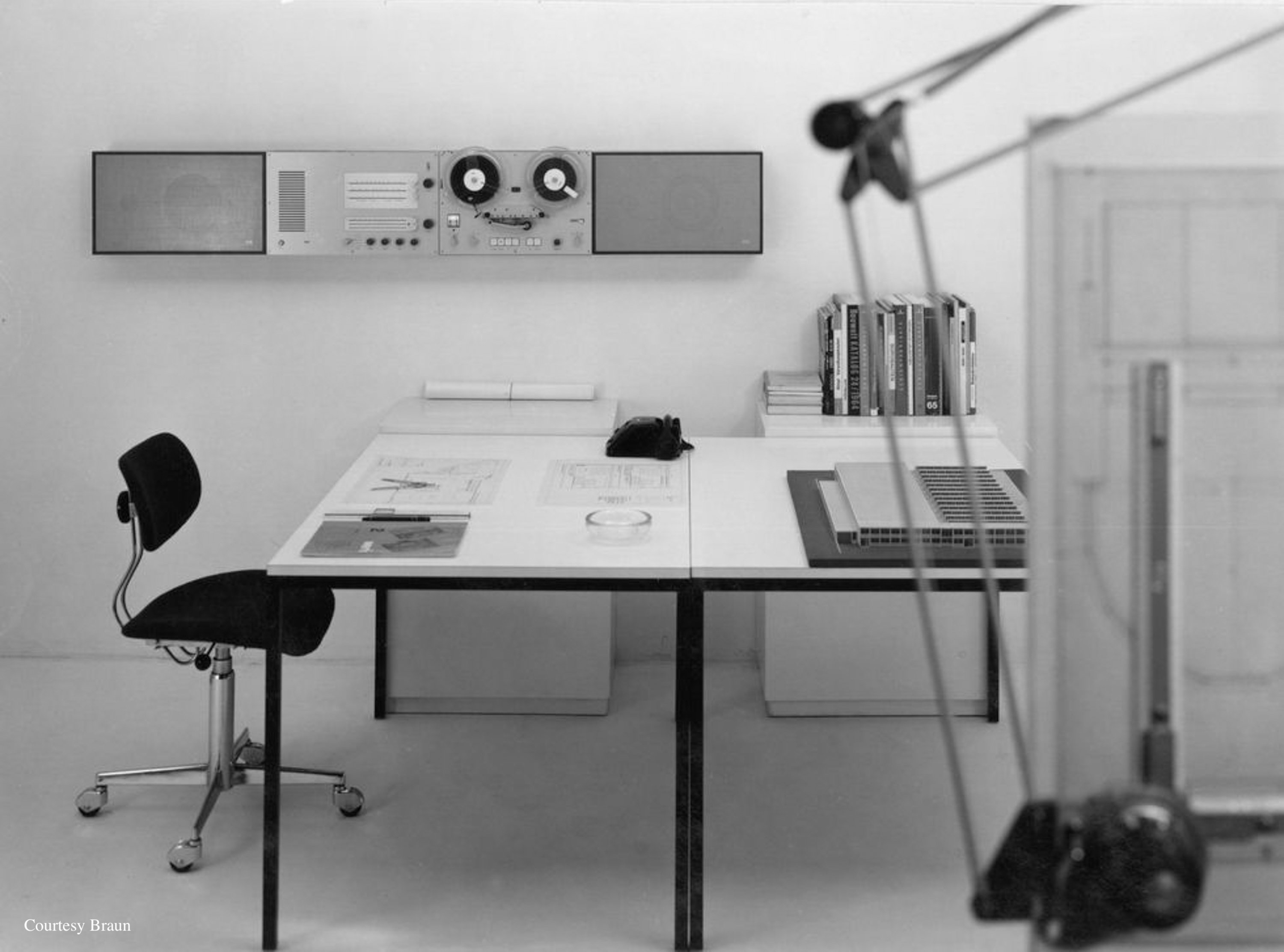
FEATUREING DIETER RAMS
Braun Audio
English text is at the bottom of this page
ドイツはクロンバーグ、自身が設計した主張のない住居。日本風に設えた庭を見やる、自然光の溢れる書斎で、ディーター・ラムスは一人机に向かっている。壁にかけられたアルミニウム製のオーディオシステムは白い光を纏い、その静謐な空気の中に溶け込んでいる。ゲイリー・ハスウィット監督によるドキュメンタリー映画「Rams」(2018)の冒頭、淀みないタイプライティングの音と共に彼は語り始める。彼の口からは自分の仕事を美化する言葉は一切出てこない。代わりに、デザインや社会全体が向いている方向について憂慮し、いつも眉をひそめている。Less, but better - 彼は自身のデザイン哲学をそう表現した。少なく、しかしより良く。彼の成功させた数多くのプロジェクトと、インダストリアルデザインやその他の分野に与えた影響の大きさからしたら、あまりにも慎ましい言葉のように思える。しかしその言葉は確かに、プロダクトの持ちうる本質的な価値をストイックに追い求めた彼の功績を、雄弁に物語っている。
1955年当時、ブラウンのオフィスの設計を依頼されたラムスは、その仕事ぶりと才能を買われ、プロダクトデザイナーとしてスカウトされる。当初は建築にしか興味が無かったラムスも、ブラウンの製品が持つ可能性に魅了され、その開発にのめり込んでゆく。その後の活躍ぶりについては言うまでもない。世界初のポータブルレコードプレイヤー「TP1」を皮切りに、透明な蓋を持つ初めてのオーディオである「SK4」など、プロダクトの歴史上重要な製品を次々に打ち出す。ブラウンは戦後ドイツのライフスタイルの土台を作り、ラムスはそのルックスも相まって「Mr.ブラウン」と呼ばれるほどの企業の顔となった。それらの製品群は実際にはデザインチームスタッフ間での連携による賜物でもあったが、ラムスという1人のスターを作り上げることはブラウンにとって有効な戦略であった。
しかし、ラムス自身は職人気質の内省的な作り手であった。成功を重ねてゆくにつれ、彼は自分がデザイナーとして持つ社会への責任について意識的になっていった。そして “ 私のデザインは果たして良いデザインだろうか?” という答えの無い問いを自らに突きつける。彼の提唱した「良いデザインの十か条」は、評価の基準を外部に求めない彼の独創性と、厳格に自らの仕事と向き合おうとする姿勢の現れである。そしてそれは、今なおデザインを評価する上での指標としての価値を失っていない。
良いデザインは、
1. 革新的である(最先端の技術を取り入れている)
2. 製品を使いやすくする(使いやすさを妨げる要素は排除される)
3. 美的である(美しい製品は私たちの日常をより良くする)
4. 説明不要である(製品をみれば構造や使い方が分かる)
5. 主張しない(機能に徹し、使用者の自己表現の余地を残している)
6. 誠実である(実際以上に革新的に見せたり、価値があるように見せたりしない)
7. 長く残る(流行に捉われず、価値が失われない。ーこの使い捨ての社会においてさえ)
8. ディテールまで徹底されている(全ては考え抜かれて決定される)
9. 環境に優しい(資源を浪費せず、生産から廃棄まで汚染を最小限に)
10. 可能な限りデザインされていない(デザインは必要な側面にだけなされるべき)
このように明確に言語化された価値基準は製品を評価するうえでの公平さにつながるもので、大量生産されて大衆の生活に溶け込んでいくデザインにおいては重要な意味を持つだろう。Appleのデザイナーであったジョナサン・アイブも、ラムスのデザイン哲学をモデルとしていたとされる。つまり、ラムスの思想は現代の生活の中にも色褪せることなく息づいている。
「良いデザインとは何か、それは人間のことを理解していない者には分からない」
映画の冒頭でラムスが言った言葉が、ふとした瞬間に思い出される。彼は製品を見つめることと同義にその先の人々や社会をみつめ、さらには自分自身をも見つめているのかもしれない。
Dieter Rams (1932-)
ドイツはヴィースバーデン出身のインダストリアルデザイナー。Braun社のチーフデザイナーを務め、機能主義に徹しながらも魅力的な製品を多く生み出した。Vitsoe社との協働では、シェルビングシステム等革新的な家具も多くデザインした。彼の提示した「良いデザインの10ヶ条」は後にアップル社のハードウェアにも影響を与えたと言われる。
Braun (1921-)
マックス・ブラウンによりドイツはケロンベルクで創業された電気器具メーカー。当時としては画期的なラジオの工場生産に始まり、ポータブルレコードプレイヤーを初めて世に送りだすなど革新的な商品を多く打ち出し、モダンなライフスタイルの礎を築いた。日本でもシェーバーや電動歯磨きなどが生活に深く浸透した。
Kronberg, Germany, is an unassertive residence designed by Dieter Rams. Dieter Rams is alone at his desk in his study, which overlooks a Japanese-style garden and is flooded with natural light. The aluminum audio system hanging on the wall is bathed in white light and blends in with the tranquil air. At the beginning of the documentary film "Rams" (2018), directed by Gary Hustwit, he begins to speak with the sound of stagnant typewriting. Not a single word from his mouth glorifies his work. Less, but better - that's how he describes his design philosophy. Less, but better. Seems too modest a phrase considering the number of projects he has successfully completed and the impact he has had on industrial design and other fields. But they certainly speak eloquently of his stoic pursuit of the intrinsic value that products can have.
In 1955, when Rams was commissioned to design Brown's office, he was scouted as a product designer because of his work and talent. Initially interested only in architecture, Rams was fascinated by the possibilities of Braun's products and became involved in their development. Needless to say, his subsequent successes were nothing short of spectacular. Starting with the world's first portable record player, the TP1, he went on to create a series of important products in the history of products, including the SK4, the first audio system with a transparent lid. Braun laid the groundwork for the postwar German lifestyle, and Rams, coupled with his looks, became the face of the company, earning him the nickname "Mr. Braun. While these product lines were in fact the result of collaboration among the design team staff, the creation of a single star in the form of Rams was an effective strategy for Braun.
Rams himself, however, was an introspective maker with a craftsman's spirit. As his successes mounted, he became increasingly conscious of the social responsibility he had as a designer. He asked himself the unanswerable question, "Is my design really good design? He asked himself the unanswerable question, "Is my design really good design? The "Ten Articles of Good Design" that he proposed are an expression of his originality and his attitude of facing his own work rigorously, without seeking external criteria for evaluation. And they have not lost their value as indicators for evaluating design.
Good design is
1. innovative
2. makes the product easy to use
3. aesthetic
4. not requiring explanation
5. not overstated
6. sincere
7. long-lasting
8. thorough down to the smallest detail
9. environmentally friendly
10. as little designed as possible
This clearly articulated set of values leads to fairness in evaluating products, which is important in the context of mass-produced design that is integrated into the lives of the masses. Rams's design philosophy is said to have been a model for Jonathan Ive, the designer of Apple. In other words, Rams' philosophy is still alive and well in modern life.
He said, "No one can know what good design is who does not understand human beings.
Rams's words at the beginning of the film come back to me in a moment. He may be looking at the people and society beyond the products as well as at himself.
In this exhibition at Richt Gallery, several audio products designed by Rams in the 1960s and 1970s are on display, and visitors can actually listen to the sound of the products. There are plenty of beautiful exterior photos on the Internet, but these are functional tools designed for listening to music. Rams designed these tools by imagining what it would be like for someone to put their favorite record on a turntable, place the needle on it, and listen to the music every step of the way. We touch them, drop the needle, listen to the sound coming through the speakers, and imagine him alone at his desk.
The fact that after more than 60 years, Apple products still work with Braun audio is a testament to the power of technology and its connection to the past. Technology not only evolves, it can also suddenly connect us to the past. And that suggests to us that the Rams philosophy will fade away.